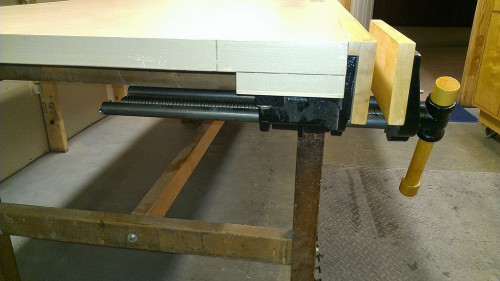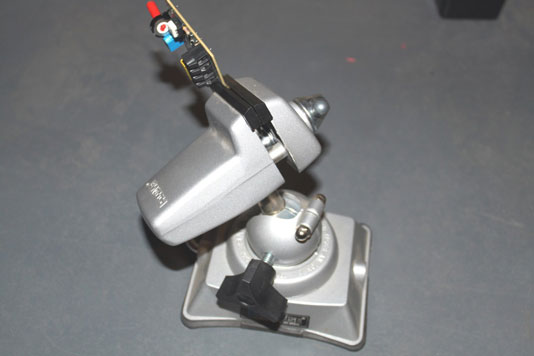
- Drill holes in the workbench – Using a drill, make holes at the height that you want your vise to be. It is important to...
- Screw the vise in – Once you have drilled the holes, use screws to attach the vise to the workbench. Be sure to tighten...
- Clamp it down – Finally, clamp down any excess screws so that they don’t move and cause problems with your vise.
How to install a woodworking bench vise?
- Things to know:
- You have to space the vise and dogholes around the bench legs and any facevise mounting hardware.
- You also can hold stock vertically between the movable jaw and the bench.
- A quick release, available on some tail vises, speeds up big changes in vise position. ...
How to build a workbench simple DIY woodworking project?
How to Build your own DIY Workbench
- DIY Workbench Tools Needed. Orbital Sander– Ryobi makes a nice one.
- DIY Workbench Supplies Needed. This simple DIY Workbench can be made for about $175 in materials cost. ...
- Cut All of the Wood Pieces. ...
- Start Assembly, Making the Top First. ...
- Assemble the Bottom. ...
- Cut the Plywood and Attach. ...
- Stain and Finish the Workbench. ...
- Get to Work! ...
How to design and build the perfect Workbench?
- You need 4 - 4 foot lengths of 2x4s
- Set up the sled so that it cuts between a 1/16 and 1/8 of an inch more than 3 1/2 inches
- Measure the height of the mortise (2.436 inches)
- Measure the height of the 2x4 (3.481 inches)
- Subtract the smaller from the larger and divide by two (0.5225 inches)
How to make a wood vise?
Make a Bench Vise for Woodworking
- What You Need. About 16 linear feet of one by six hardwood (actual measurements ¾” x 5½”). ...
- Front Jaw. Cut two 32” long pieces from the one by six board. ...
- Rear Jaw. The rear jaw is L-shaped. ...
- Drill Holes for the Hex Bolts. Drill two ½” holes through the front jaw 3” from the short edge and 2 ¼” from the top edge. ...
- Make Handles. ...
- Use Your Bench Vise. ...

Where is the best place to put a vise on a workbench?
That's why face vises usually are placed on the left end of the bench. When sawing workpieces (below), a left-side vise also lets you hold onto the offcut, with the keeper piece safely secured in the jaws, resulting in a cleaner cut. But that said, you can mount a vise wherever it suits you best.
How do I add a vise to my workbench?
7:4417:21Add a vise to the $30 Work Bench. - YouTubeYouTubeStart of suggested clipEnd of suggested clipAround that hole. Cut it out drill. Through it in two edges. And split the whole thing in half. I'm.MoreAround that hole. Cut it out drill. Through it in two edges. And split the whole thing in half. I'm. Gonna do is assemble this around the vise screw. And then put screws through the edge.
How do you attach a woodworking vise to a workbench?
3:396:41Installing a Woodworking Vise - YouTubeYouTubeStart of suggested clipEnd of suggested clipI clamped the vise back in place and used an impact driver with a socket to drive the lag screws. InMoreI clamped the vise back in place and used an impact driver with a socket to drive the lag screws. In. The vise also gets secured on the front face through the jaw.
How do you fix a vice to a workbench?
0:252:11How to Fix a Vice on a Workbench | Woodworking - YouTubeYouTubeStart of suggested clipEnd of suggested clipMake sure the handle is jutting out that you can loosen and tighten the vise easily mark the spotMoreMake sure the handle is jutting out that you can loosen and tighten the vise easily mark the spot where you will drill a hole using a pencil. Use a center punch to make the pilot holes.
How do I attach a woodworking vise?
2:274:38How to install a Woodworking Vise// Woodworking// Quick Release ViseYouTubeStart of suggested clipEnd of suggested clipThen install the screws that will mount the front of the vise to the front jaw take quick-releaseMoreThen install the screws that will mount the front of the vise to the front jaw take quick-release vise you just barely want to put the screws in the guide rods in place so that you can situate.
What size are bench vise bolts?
Re: Mounting a Bench Vise Mine used 7/16 bolts to mount. Make sure to hang the jaws over the edge of the table, just as ware did. 7/16 seems to be right.
What clamping position should be considered when mounting a vise on a workbench?
What clamping position should be considered when mounting a vise on a workbench? The vise should be positioned so that a long piece can be held vertically in the jaws without interference from the workbench.
How do you use a bench hook?
0:554:28How to Use a Bench Hook - YouTubeYouTubeStart of suggested clipEnd of suggested clipFor a cross cut or shoulder cut you take the hook of your bench hook. And place it up against theMoreFor a cross cut or shoulder cut you take the hook of your bench hook. And place it up against the front edge of your workbench. Then you take your work. And place it up against the fence.
What kind of wood do you use in a wood vise?
Generally, maple is used for wood vise jaws as it is durable enough to withstand the clamping force of a vise. However, softer woods such as pine can be used if your projects will be made from mostly soft hardwoods like cherry to prevent marring.
What are the holes for on a workbench?
Take a look at any woodworking professional's workbench and you might wonder, why there are holes randomly cut into the top? These holes are not randomly placed, and are actually called “dog holes.” Dog holes help woodworking professionals hold the piece they're working on.
What is a vise clamp?
noun A supplemental vise-jaw of such form as to hold work of unusual shape or material without injury. noun A clamp by which a vise can be temporarily secured to a bench or other object.
How do you hang a vise without a bench?
7:3714:02How to mount a vise without drilling holes in your workbench - YouTubeYouTubeStart of suggested clipEnd of suggested clipNow just just securing the very bottom lip of this bench because that's what it was that was theMoreNow just just securing the very bottom lip of this bench because that's what it was that was the whole purpose of this so i didn't have to drill into the into the workbench.
How do you make a removable bench vise?
0:052:13Woodworkers need a removable machinist vise/anvil mounting system!YouTubeStart of suggested clipEnd of suggested clipAttach. It with a glue and screws. So it's nice and secure. This will clamp inside my woodworkingMoreAttach. It with a glue and screws. So it's nice and secure. This will clamp inside my woodworking vice no muss no fuss. You've probably seen people do this before.
How do you fit a vice?
13:0022:26How to fit a Woodworking Vice - YouTubeYouTubeStart of suggested clipEnd of suggested clipAbsolutely spot-on this is a 25 millimeter drill bit and it fits just inside these outer two holes.MoreAbsolutely spot-on this is a 25 millimeter drill bit and it fits just inside these outer two holes. Now you may not be so lucky depending what vice you're fitting.
How long does it take to attach a bench dog to a bench?
This might be useful in the future if I'm cutting something quite long and need the side-to-side clearance and support in the middle. This took about 6 seconds.
What to do if you don't have a table saw?
If you don't have a table saw, you can do this with a circular saw or even a handsaw. Just make sure to mark a baseline, and keep everything secure.
Can you reinforce dado joints?
Allow the glue to cure. You could reinforce this dado joint with screws or dowels if you want, but with this much contact and the dimensional strength of the plywood, I think it'll stand up to any force I can apply with my hands. Also, at this point, I wiped on a coat of Danish Oil.
What other tools can you mount next to a bench vise?
A bench grinder is a great tool to have next to your bench vise. With a capable motor and two grinding wheels, having it near your bench vise allows you to easily and constantly keep your tools sharp. If you are doing metalwork, a bench grinder allows you to smooth out and polish workpieces.
How to mount a pipe clamp bench vise?
If you want to DIY a custom-fit pipe clamp bench vise. Though you can purchase ready-made ones if you prefer. Here’s how to install a bench vise pipe clamp:
What makes the ideal workshop table with a bench vise?
Ideally, you have a strong steel bench for mounting a bench vise, with a plywood replaceable top to cushion the rigid steel and prevent damage or rust marks on your projects.
Why do vises have lined jaws?
As the most common of vise types, these typically have either wood or lined jaws to help prevent damaging the workpiece you clamp from the clamping jaws.
What is a vise tool?
Being made out of two parallel jaws, an adjustment screw, and a base; a vise is a tool that’s simple to both operate and maintain.
What is metal vise?
Metalworking vises are mainly used to clamp down metal but are also more viable than woodworking vises when needing to secure large and heavy materials.
What is a good alternative to a bearing puller?
A vise can be a good alternative to a bearing puller for removing armature bearings. The piece is clamped securely to a vice while the bearing is pried off with a screwdriver.
